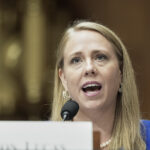James Woods has his sights set on finding ways to help California deal with repeated years of severe wildfire seasons, and the prospect of more seasons in which record losses from large blazes may lie ahead of us.
Woods has been making rounds at insurance conferences talking about wildfire solutions for California, and he’s been busy working with lawmakers and the governor’s office to develop plans to help mitigate the threat of wildfires and to help pay for them.
Woods has a track record of dealing with large and potent disaster issues facing Californians. He was instrumental in helping to create the California Earthquake Authority.
Woods was formerly co-leader of Mayer Brown’s Global Insurance Industry Group and chair of the LeBoeuf, Lamb, Greene & MacRae Insurance Practice. He now owns and operates Woods Group Solutions, headquartered in Sonoma, Calif.
He spoke with Insurance Journal about his most recent efforts in a follow up conversation in which he spoke with Insurance Journal in February about finding solutions to the state’s wildfire problems.
This has been edited for brevity and clarity.
Insurance Journal: When we last spoke we talked about what California can do in regards to being better prepared for wildfires and catastrophic wildfires. I’m understanding there’s some new developments. Can you talk about what’s going on?
Woods: Yes. There are some exciting developments. Gov. Newsom has done a fantastic job in preparing a 50-page report addressing wildfire, and, in some instances, insurance solutions for wildfires. He has indicated in his report that climate change has created a new wildfire reality for California. He’s indicated that 15 of the 20 most destructive wildfires in the state’s history have occurred since 2000. Ten of the most destructive wildfires have occurred since 2015. He also has taken a look at evaluating state level resource backdrop options, increasing transparency and reliability protections for consumers, and allocating responsibility for wildfire costs.
One idea that he had is a liquidity-only fund, which would provide some bridge financing for what utilities are able to raise under SB 901, which is sponsored by Sen. Dodd of Napa, also examining our fault-based standard of endurance condemnation, and thirdly, creating a catastrophic wildfire fund.
IJ: Can you tell us a little bit more about that fund?
Woods: I think that so long as the state embraces a standard of fault being irrelevant in connection with any wildfires that are created by a utility’s equipment, which is the case under so-called inverse condemnation, then the state has to be prepared to allocate costs. One mechanism for doing that is the creation of a California Wildfire Authority. Significant members of the state legislature are considering that now.
Assemblyman Chad Mayes has been a proponent of that type of an approach, and Senator Bob Hertzberg has also been a proponent of that type of an approach. I have put together some ideas for Senator Hertzberg and his staff to consider. It would be a financing for a $20 billion Wildfire Authority that is composed of four layers.
One of the layers would be a $4.5 billion layer that would be a utility capital contribution. The source of funds there would be corporate equity of the state’s utilities, the investor-owned utilities. I think one could arrive at that by taking the service territory of utility and deriving a percentage of contribution there from. Also, I’ve penciled in half-a-billion dollars for the state’s smaller utilities, rural utilities and the like. Each of those also, their service territories would dictate the amount of contribution.
The second layer would be an SB 901 layer borne by the state’s utility rate payers. I’ve penciled in $1.5 billion there thinking that the maximum amount that a utility repair would be willing to contribute is about $7.50, and understanding that under SB 901, $5 per $1 billion of rate payer can be borne or passed on to the state’s rate payers so long as the Public Utility Commission so approves.
A third layer would be a capital’s market layer that could be as large as $8 billion. The source of funds would be the California Taxpayer. Also, sovereign well funds could be approached.
A final layer would be a state insurance layer, and the source of funding there would be California Taxpayers. This would be through reinsurance, perhaps four and a half-billion dollars, an ILS, which are insurance link securities of about a half-a-billion. The total thereof is $20 billion.
IJ: It sounds like we’re at a critical juncture here as far as wildfire risk in California. Is that a good assumption?
Woods: I think it is. In fact, the governor has been very quick to try to come up with innovative and business practical consumer centric solutions. He demanded that his strike force report within 30-60 days, which they did. Now, there needs to be follow through as to whether or not any of these proposals can be implemented in order to properly address a problem that we expect to occur annually in the future that is devastating wildfire losses in part due to climate change.
IJ: What should our insurance professional listeners and readers take away from all of this?
Woods: Well, I’d like our insurance leaders to become active in proposing solutions, not just reacting to situations. It would be very helpful if they were directly in the mix, not just reacting to other proposals, but coming up with some worthwhile proposals. Let’s remember, when the California Earthquake Authority was prepared many years ago, it was the insurance industry that led the creation of that. It was a very innovative way to address a problem. That was the lack of potential earthquake capacity for California consumers.
Today, we have a lack of wildfire capacity by insurers. It would be helpful if they stepped forward with some ideas that will help mitigate the damages and serve consumers.
Related:
Was this article valuable?
Here are more articles you may enjoy.


 Head of EEOC Urges White Men to Report Discrimination
Head of EEOC Urges White Men to Report Discrimination  Judge Green Lights New York’s Driver’s License Law, Rejecting Trump Challenge
Judge Green Lights New York’s Driver’s License Law, Rejecting Trump Challenge  Fire Damages Portland, Maine’s Historic Waterfront
Fire Damages Portland, Maine’s Historic Waterfront  Louvre Tightens Security After $102M Jewel Heist, Installs Bars on Infamous Window
Louvre Tightens Security After $102M Jewel Heist, Installs Bars on Infamous Window 

